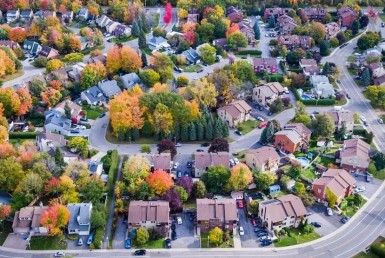Housing market predictions: The forecast for the next 5 years
Housing market predictions: The forecast for the next 5 years
By Dina Cheney
It’s been a wild real estate ride over the last few years. After a red-hot market characterized by very low interest rates and frenzied bidding wars, mortgage rates increased to their highest level in more than 20 years. The average rate for a 30-year mortgage more than doubled between August 2021, when it was just 3 percent, and October 2023, when it reached 8 percent. Rates were hovering at around 7 percent as of April 2024. As you might imagine, this trend has led to a slowdown in buying activity. Even so, with inventory still scarce, home prices remain unaffordable in many parts of the U.S.
Real estate forecasts for the next 5 years
There are plenty of predictions about where the housing market is going this year. But what about further out? After all, buying a home often requires long-term planning. We asked several industry experts to peer into their crystal balls and give us their real estate forecast for the next five years. Here’s looking at you, 2029.
The current housing market
. Home sale prices: The country’s median existing-home sale price in February 2024 was $384,500, according to the National Association of Realtors (NAR) — up 5.7 percent year-over-year. For new-construction homes, National Association of Homebuilders (NAHB) data shows that February’s median sale price was slightly higher at $420,500.
. Inventory: The supply of homes for sale remains quite low. Per NAR data, the inventory of unsold existing homes was at a 2.9-month supply in February, well below the 5- to 6-month supply that a balanced market would require.
. Days on market: With high mortgage rates putting a purchase out of reach for many, homes are taking longer to sell. In February, the median length of time homes spent on the market was 38 days, up from 34 days one year earlier, per NAR.
. Homes sold: Nationwide sales of existing homes have risen lately, up 9.5 percent in February 2024, per NAR. Meanwhile, the pace of new single-family home sales rose 1.5 percent in January 2024, up 1.8 percent from a year earlier, per NAHB data.
. Mortgage rates: According to Bankrate’s weekly survey of large lenders, the average 30-year mortgage rate as of April 10 was 7.08 percent.
Forecast for mortgage rates and types
Lawrence Yun, NAR’s chief economist, believes mortgage interest rates could remain at a general level around 7 percent for most of 2024. However, he thinks rates have likely crested: “I believe we’ve already reached the peak in terms of interest rates,” he told attendees at a November NAR convention. Within two years, he says, the rate should return to 5.5 or 6 percent, assuming the federal budget deficit does not put permanent upward pressure on all borrowing costs.
Because rates are high, Yun foresees a greater interest in adjustable-rate mortgages through next year. However, after that, he predicts 90 percent of Americans will return to the traditional 30-year fixed-rate mortgage.
Greg McBride, CFA, Bankrate’s chief financial analyst, thinks the 30-year fixed will remain the dominant mortgage product. “A fixed-rate mortgage provides the certainty borrowers want,” he says. “It is the best gauge of affordability, and there is very little upfront advantage to taking an adjustable-rate mortgage, as those rates aren’t much lower than fixed rates right now,” he says.
Predictions for home prices
Yun foresees no major changes in purchase price tags on a nationwide level next year, with fluctuations of only about 5 percent one way or the other. Overall, in five years, he expects prices to have appreciated a total of 15 to 25 percent.
McBride predicts home prices will average low- to mid-single-digit annual appreciation over the next five years. This rate of appreciation, he says, is consistent with the long-term average of home prices increasing by a rate that hovers a percentage point above the inflation rate.
Will the housing market crash?
While it may show bubble-like characteristics, Yun does not expect the residential real estate market to burst. He does predict that sales will be at a low point next year, with only 5.3 million units sold, but he foresees a gradual increase afterward, up to an annual 6 million units by 2027.
Despite today’s higher mortgage rates, home prices are still strong, he adds. Even if they decline 5 percent or even 10 percent next year, that’s not anywhere close to crashing, which he says is characterized by about a one-third drop.
“A crash happens with oversupply,” Yun says. “A 30 percent decrease will not happen, because there isn’t enough inventory.” He believes the housing supply will balance out within five years.
Many other experts agree that there is no danger of an imminent housing market crash. Not only is inventory too scarce, as Yun notes, but lending standards today are much stricter than they were back in the days of the Great Recession. Mortgage lenders are largely not issuing loans that borrowers can’t really afford anymore, which helps keep foreclosure rates low. And those who do borrow have excellent credit: a very high median score of 770, according to the Federal Reserve Bank of New York.
Will we shift into a buyer’s market?
Yun expects the overall seller’s market to continue as long as housing inventory remains low. By five years out, though, he foresees more of a balanced market, where neither the buyer or seller holds a significant advantage. Instead, the negotiating power between parties will be more equal and depend on the individual case.
Caroline Feeney of Narrative Bent, a former director of content and executive editor at real estate site HomeLight, says the shift away from a seller’s market has already begun. She also expects a balanced market within a few years, and says that 55 percent of HomeLight agents surveyed believed the markets that heated up the fastest during the pandemic — including Austin, Phoenix and Boise — would likely be the first to cool down. This scenario may already be playing out: The median home sale price in Austin was down 3 percent year-over-year, according to February Redfin data, and homes there were taking a very long 81 days to sell.
Where will new homes be built, and what kind?
With hybrid work schedules now common and commuting no longer as relevant, Yun predicts the suburban market will remain strong. He expects growth in areas with rising populations, including the Carolinas, Florida, Texas and Tennessee.
Backing up his prediction, Danushka Nanayakkara-Skillington, assistant VP of forecasting and analysis for NAHB, says 50 percent of new single-family construction is in the South. Southern markets scored big in Bankrate’s most recent Housing Heat Index as well.
The number of single-family homes under construction decreased at the end of 2022. But the number of multi-family homes under construction has increased over the last few years — Feeney credits this growth in part to their lower price tags and the pressure on municipalities to relieve shortages and provide more affordable housing.
Still, with high mortgage rates and inflationary building material prices, Nanayakkara-Skillington expects the multi-family market’s growth to stabilize within a few years, with the number of new housing starts decreasing.




